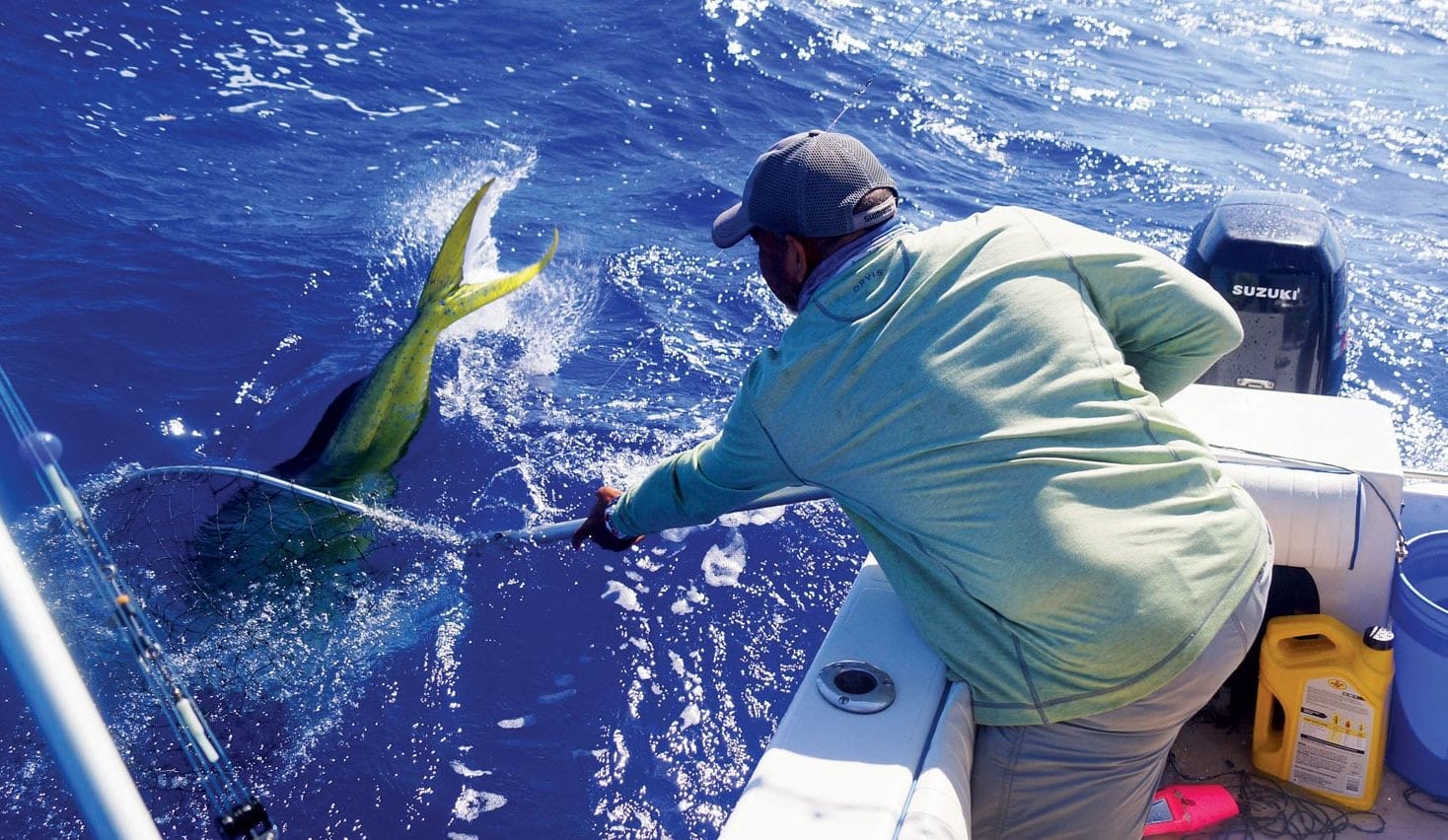
Sports fishermen are notoriously loathe to give up the location of a secret fishing hole. Today, some of the best places to catch fish are right out in the open sea, well-marked and mapped. These are FADs or fish aggregating devices. FADs, especially those in the waters surrounding Puerto Rico and the U.S. Virgin Islands, are man-made devices such as bright yellow buoys that are anchored to the ocean floor and attract fish. FADs are not new in these areas. However, three years ago there was a concerted effort to deploy more FADs in these waters. Right after this deployment, Dr. Wessley Merten, president of the Beyond Our Shores Foundation, an organization which conducts fisheries science research throughout the region, began research in collaboration with the Puerto Rico Department of Natural and Environmental Resources (PR DNER) to look at FAD use, performance and effectiveness. This research offers intriguing insights for local and visiting sport fishermen.
“The Puerto Rico and U.S. Virgin Islands FAD systems were installed to enhance and facilitate sportfishing opportunities in territorial waters of the U.S. Caribbean Sea and are federally funded,” says Merten. “One of the key objectives of the FAD programs is to increase recreational catch and reduce time and fuel spent searching for fish schools.”
In Puerto Rico, eight FADs were placed with locations spanning from north of San Juan to Fajardo in the Atlantic Ocean. In the U.S. Virgin Islands, ten FADs were positioned off St. Thomas and St. Croix, in both the Atlantic Ocean and Caribbean Sea. These locations were chosen based on factors such as feedback from fishermen; ease of access and proximity to fishermen, and safety for shipping interests.

To collect data, Merten worked with local fishermen such as Captain Luis Burgos, who owns and operates Caribbean Fishing Academy Charters in San Juan.
“We participated by taking Dr. Merten and his team out on our vessels to collect vital data from devices such as acoustic receivers and high definition cameras from which to identify the fishermen and species that used the FADs. We even caught dolphinfish, wahoo, and silky sharks around the FADs, in which we placed satellite tags to identify migration patterns,” says Burgos.
One major take-home message of Merten’s research is that FADs are used by a wide range of fishermen. More specifically, charter boats were the most frequent day-to-day users, which means that local and international visitors that hire a charter in the San Juan Metro area can expect to fish at FADs. This goes for spearfishing charters, too. This research also revealed that recreational, charter, and commercial fishing sectors overlapped in FAD use. The latter sector used the FADs earliest in the day. Therefore, given the open access nature of the FAD system, local and visiting anglers can expect to compete for fish the most during early hours of the day but during the afternoon anglers are likely to have a more exclusive experience.
In terms of types of fish found at FADs, dolphinfish is the most frequently caught fish at the USVI and Puerto Rico FADs, followed by wahoo. Anglers have also reported catching tunas such as yellowfin, blackfin, and skipjack. Additionally, anglers catch blue and white marlin, sailfish, and spearfish around the FADs, though these species are typically released.

While Merten’s research on FAD effectiveness and performance is ongoing, captains who participated in the research already feel that the FADs are working.
“FADs are very important to my operation because they give us around 85 percent on a successful catch rate,” says Captain Luis Lagrandier, of Puerto Rico Sportfishing Charters, who specializes in light tackle fishing and is based in Dorado. “This high catch rate is very attractive to our guests who, of course, want to catch fish.”
There is a seasonality factor to FAD productivity, according to Alexis Sabine, fisheries biologist at the U.S. Virgin Islands Department of Planning and Natural Resources, Division of Fish and Wildlife (USVI DFW), who collaborates with Merten.
“We would like local and visiting sport fishers to understand that the FADs can be highly productive during certain times of the year, yielding large amounts of fish such as dolphinfish and yellowfin tuna, while other times their catches around the FADs may be low. This does not necessarily mean that the FADs are not working, just that natural conditions such as season, sea conditions, and currents can influence presence of highly migratory fish species around the FADs,” says Sabine.

There is not a lot of research on FADs in the Caribbean. That’s what makes Merten’s work through his research foundation and collaboration with PR DNER and the USVIs DFW so valuable. Their continued research will seek to better understand how fish populations and fishermen use FADs seasonally, identify periods of overlap, and devise strategies to sustain pelagic fish populations while maximizing recreational fishing opportunities.
“We encourage sport fishermen to get involved in our FAD research program by signing up for a free dolphinfish tagging kit to tag and release small, healthy, dolphinfish at the FADs. This type of work will allow us to investigate dolphinfish seasonality and movement dynamics around the FADs. We also need more vessels to participate in our ‘catch and effort’ program for us to gather more examples of FAD use, effectiveness, and performance,” says Merten.
For more information, visit: www.beyondourshores.org/fads
Reel It In: Examining the Environmental Impact of Fish Aggregating Devices (FADs) in Sport Fishing





